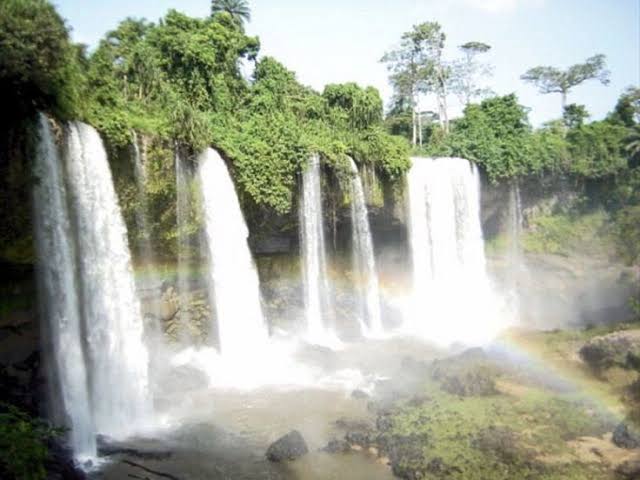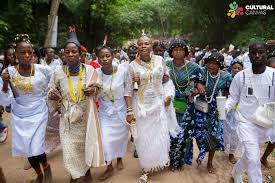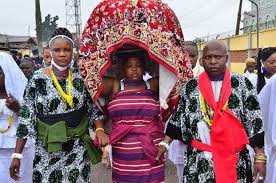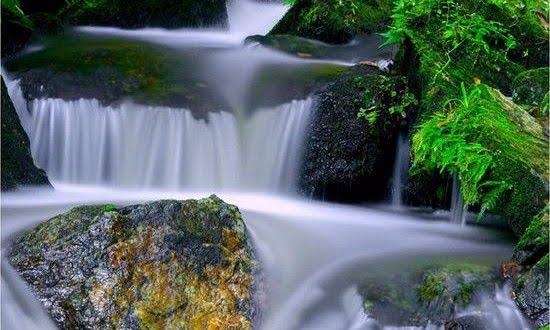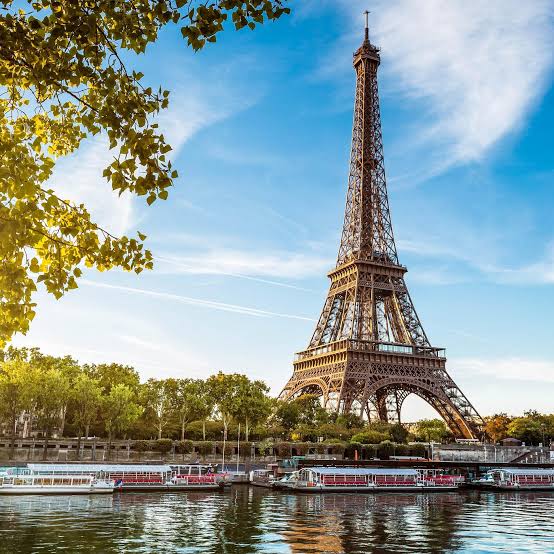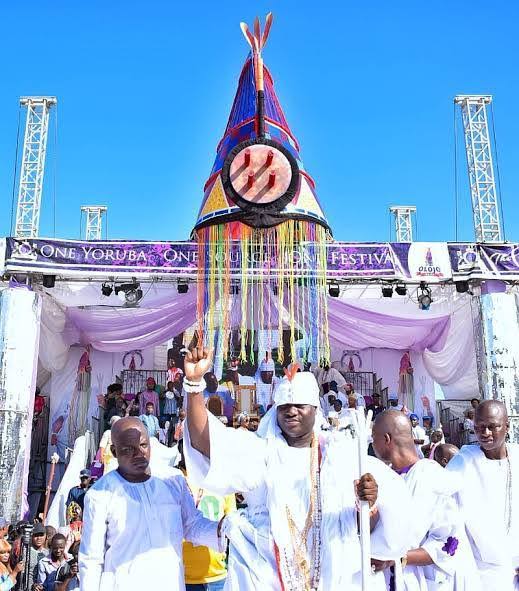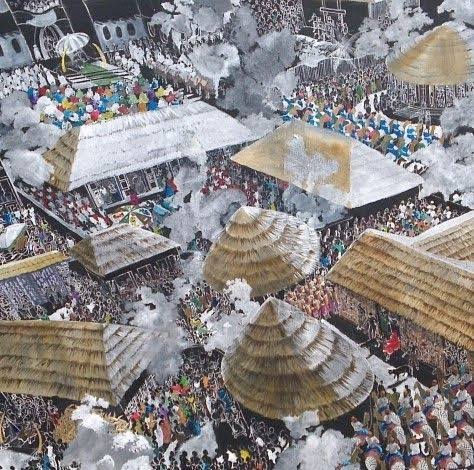Owu Waterfalls (often written Owu Falls) is one of the Kwara State best-known natural attractions. It sits in the Owa-Onire / Owu area of Isin (sometimes listed under Ifelodun/Isin LGA in different sources) and is widely celebrated for its dramatic single-drop curtain that plunges into a cold pool surrounded by steep, forested escarpments. The fall is reputed to reach about 330 feet (≈100–120 m) in total drop and is commonly described as one of the highest waterfalls in Nigeria and West Africa.
THE ENVIRONMENT AND LANDSCAPE
Owu sits in a landscape of undulating hills, rocky outcrops and thick tropical vegetation. The waterfall spills over a high escarpment into a shallow basin, producing a cool microclimate, damp, misty air, lush mosses and riparian vegetation, that contrasts with drier savanna and farmland in surrounding lowlands. The cliff and rock formations around the fall provide scenic vantage points and small hiking routes; the pool below and the stream that drains it maintain perennial flow in many seasons, though volume varies with rainfall.
Ecological notes / threats: researchers and local studies have flagged ecological pressures on the site: unmanaged visitor waste, uncontrolled foot traffic that damages vegetation, nearby farming encroachment, and the risk of illegal quarrying or logging in upland catchments, all of which could reduce water quality and the aesthetic value of the falls if left unchecked.
LOCAL PEOPLE AND CULTURE
The communities around Owu Falls are primarily Yoruba speaking people of the Isin/Owa area. Locals have traditional ties to the land and often regard the falls as part of the community’s identity and heritage. Historically the site was “discovered” and opened to visitors by community members and local tourism officials; community elders, sometimes act as informal guides and custodians. Local attitudes are generally supportive of tourism because of the income opportunities it brings, but several studies point to a gap between local expectations and the degree to which they currently benefit from tourism income and decision making.
CURRENT TOURISM PACKAGING AND VISITOR EXPERIENCE
Presently, Owu Falls is mostly visited as a day-trip/eco-day-out destination. Visitor profiles include domestic tourists (families, school trips), nature lovers, photographers, hikers and small groups of international travellers who make the journey off the beaten track. The common features of a visit: Short hike or stair/rock descent from the village to the viewing points and pool, opportunities for photography, swimming (where safe), light rock-climbing and picnicking, informal local guides (community members) who help visitors negotiate trails and describe local stories and how it’s (not) packaged: there is limited formal packaging, few official tour operators provide structured packages, minimal signage and limited formal interpretation (no visitor centre or museum displays). That makes Owu attractive for adventure travellers but harder for mainstream, less-adventurous tourists. Media posts and travel blogs often position it as a “wonder in the wilderness” and a short drive from Ilorin, which helps bring day-trip traffic.
AVAILABLE FACILITIES(today)
Facilities are basic and variable (often depending on who is visiting and whether there are short-term pop-up vendors): Simple parking near the village; informal entry points, local guides and sometimes small food/drink vendors near the trailhead, minimal built walkways or viewing platforms in most places; rustic steps or tracks on the descent, little or no formal sanitation, first-aid, lifeguard or dedicated parking management, limited signage, interpretation boards or secured overlooks.
ECONOMIC IMPORTANCE— local and state level
Tourism at Owu yields multiple economic benefits, even in its underdeveloped state, direct income for local guides, food vendors, drivers and small-scale accommodation owners when visitors stay nearby, indirect benefits for transport operators (drivers, taxis), artisans (souvenirs), and farmers who sell food to tourists or vendors.
STATE VISIBILITY: Owu is a natural asset that strengthens Kwara’s tourism portfolio (complementing historic and cultural attractions in Ilorin), which can attract state and private investment if packaged effectively.
POTENTIAL FOR JOB CREATION: with improved facilities and marketing, the site could generate more stable employment and entrepreneurial opportunities for youth and women in nearby communities. However, studies show local residents often expect greater participation in planning and a fairer share of the financial gains, a gap policy and tourism planners should be closed.
UNIQUENESS OF OWU FALLS
SPECTACULAR SCENERY: a dramatic single-drop curtain and a deep pool framed by cliffs and dense vegetation adds value to its uniqueness, e.g. excellent for photography and nature lovers.
PERCEIVED UNIQUENESS: widely promoted as one of the tallest falls in Nigeria/West Africa is a strong unique selling point.
PROXIMITY TO ILORIN AND REGIONAL MARKETS: accessible enough for daytrippers and weekend visitors, which helps demand is another uniqueness.
COMMUNITY INTEREST: locals people are generally welcoming and ready to engage in tourism enterprises.
DISADVANTAGES AND CONSTRAINTS
✓Poor access infrastructure: rough roads, lack of formal parking and signage make access difficult especially in the rainy season.
✓Limited facilities: lack of safe walkways, restrooms, visitor centre, waste management and emergency services.
✓Environmental pressure: unmanaged visitor behaviour and lack of clear conservation measures risk degrading the resource.
✓Marketing & packaging gap: the site is under-marketed in mainstream travel circuits; little formal tour product development.
RECOMMENDATIONS FOR IMPROVEMENT OF OWU FALLS
Below are the concrete steps that balance tourism growth with conservation and community benefit.
1) BASIC INFRASTRUCTURE(short term, high impact), improve and grade the main access road and create a defined parking area near the trailhead, build safe, low-impact footpaths and viewing platforms (boardwalks, railings) to protect vegetation and reduce erosion, install basic but robust restroom facilities (eco-toilets) and potable water points, provision of clear signage from main roads and on-site interpretive panels explaining geology, flora/fauna and safety rules. (These measures immediately raise visitor comfort and safety and reduce environmental damage.)
2) COMMUNITY(led management and benefit sharing)
∆ Formation of a local tourism committee (community members, youth reps, local government, Kwara tourism board) to manage site fees, coordinate guides and allocate income for maintenance and community projects.
∆ Train local guides in safety, first aid, interpretation and visitor management; certify them as official site guides (Ensures locals gain jobs and leadership while improving visitor experience.)
∆ Environmental protection & carrying-capacity planning
∆ Conduct an ecological assessment to set a sustainable daily visitor limit, protect water quality and identify sensitive zones.
∆ Install waste-management systems (bins, carry-in/carry-out rules), run regular clean-up days, and ban destructive activities like quarrying near the catchment(Keep the falls healthy for future generations and tourists.)
PRODUCT DEVELOPMENT AND MARKETING
>Package Owu as part of regional circuits (Ilorin cultural and Owu falls day tour, weekend eco-escape) and promote to domestic tour operators.
>Develop simple accommodation options (eco-lodges, community guesthouses), adventure add-ons (guided hikes, birding), and festival/event days to boost off-peak visitation.
>Use social media, the Kwara tourism board and local travel blogs to create consistent messaging and reliable visitor information (opening hours, entrance fees, safety rules).
SATETY, EMERGENCY RESPONSE AND REGULATIONS
✓Train a small volunteer rescue team; supply first-aid kits and emergency communication (radio or mobile).
✓Implement rules for swimming near the pool (seasonal restrictions), and place life-ring stations where appropriate.
✓Work with local law enforcement and the state tourism board to formalize permitted vendors and reduce informal/unsafe operations.
QUICK SUGGESTION FOR INVESTMENT PLAN (phased)
1. PHASE ONE (0–12 months): road grading, signage, community committee formation, basic paths, waste bins, guide training.
2. PHASE TWO (12–24 months): build viewing platforms, eco-toilets, small parking, marketing campaign, pilot community guesthouses.
3. PHASE THREE (24–48 months): visitor centre with interpretation, regulated adventure programming, biodiversity monitoring program and revenue reinvestment mechanism.
SUMMARY(balancing development and conservation)
Owu Falls is a high-value natural asset with clear tourism potential that’s already generating local income. The priority should be to expand tourism in ways that are safe, inclusive and ecologically sustainable: invest in basic infrastructure, formalize community participation so locals capture most benefits, apply simple environmental protections, and market the falls within regional tourism circuits.
If Kwara State and local partners follow a phased, community-centred plan they can turn Owu Falls from a hidden “wonder in the wilderness” into a model for responsible eco-tourism that supports livelihoods while preserving the landscape.

